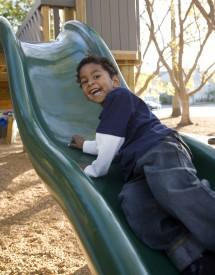Opening the Park with Shared Use
At one time, there were no parks where children could play in the small town of Earlimart. For years neighborhood advocates had their eyes on an empty lot in the middle of town – a few dry, dusty acres of land owned by the local school district. They even identified a $2 million grant that could fund the transformation of the lot into an appealing recreational destination filled with trees, play space, picnic tables, and walking paths.
But to apply for the grant, the school district and the county needed to sign an agreement detailing future plans for the property. That agreement had to include a provision that the district would relinquish control of the property for a couple of years while the county took over the development process.
This was no small task for the district and the county resource management agency, who had a long history of distrust.
"Until a few years ago, these two entities weren’t even talking to each other," says Susan Elizabeth, an advocate with the Central California Regional Obesity Prevention Program (CCROPP), which works to promote health in communities throughout the San Joaquin Valley.
Facing major challenges
Beyond the district’s strained relationship with the county, the school superintendent was already facing a number of pressing challenges, including dismal test scores throughout the district. Developing a park wasn’t high on her list.
The superintendent was also reluctant to take on the responsibility for costs or injuries associated with community use, Susan says, and concerned that the district might need the land in the future.
The county resource management agency, meanwhile, had the charge and know-how to oversee the development of the land, as well as an interest in developing a drainage system on the property to absorb excess water, process pollutants, and prevent flooding after major storms.
But because the land was owned by the school district, the county couldn’t take on the project without a formal agreement.
Finding the right expertise
Susan turned to ChangeLab Solutions’ staff of city planners, attorneys, and policy analysts to help understand and show community stakeholders how the park could be developed and maintained without the district incurring additional liability or losing its own rights to the property.
"I started to need some legal input."
"I knew nothing about how to develop parks, so a lot of the initial work I did with [ChangeLab Solutions] was developing strategies about how to move forward," Susan recalls. "And then I started to need some legal input. I don’t know who else I could ask who would have the same level of legal and planning expertise."
ChangeLab Solutions worked closely with Susan and the community to identify ways for the district to share the costs and responsibilities of developing and maintaining the plot of land through what’s known as a joint use or shared use agreement, providing model contract language and other legal and policy tools.
ChangeLab Solutions also provided sample agreements from neighboring districts to show how nearby schools implemented their partnerships.
Soon afterward, the superintendent agreed to host regular meetings with county resource management agency staff, elected officials, and other community advocates to discuss how to move forward.
Making it official
Finally, after years of tireless organizing and sometimes difficult negotiations, the school district and county signed an agreement and won the $2 million grant from the state parks and recreation department.
"All I have to do is pick up the phone, and someone will help me."
Throughout the process, Susan says, ChangeLab Solutions' guidance has been critical.
"All I have to do is pick up the phone, and someone will help me," says Susan. "Having technical assistance providers who are willing to put their feet on the ground here in Earlimart has made all the difference."
4/19/2017
Photographs by Lydia Daniller, lydiadaniller.com
